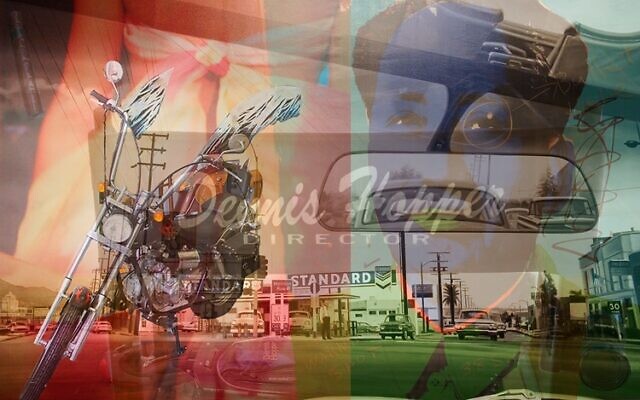The Breman Partners with Tara Theatre
A mini film series at the Tara was about Dennis Hopper, the Hollywood actor featured in an exhibit at The Breman.

The Breman Jewish Heritage Museum linked up with the recently re-opened Tara Theatre to present a three-film retrospective of Dennis Hopper, the film star best known for his 1969 film, “Easy Rider.” It was a rare venture away from the museum building on Spring Street, where it shares exhibit space and an auditorium with the offices of the Jewish Federation of Greater Atlanta.
The series, which ran on Oct. 14-15, was done in conjunction with the recent photographic exhibit by Los Angeles photographer Robert Weingarten, entitled “Icons – Selections from the Portrait Unbound,” which included 14 large photographic compositions, mostly of well-known celebrities whose fame Weingarten felt would stand the test of time.
The film series was curated and introduced by Eddy Von Mueller, a local film scholar and historian. He believes Hopper, who co-wrote the script with his co-star Peter Fonda, helped change the direction of Hollywood in the late 1960s, when the film first appeared. The surprising success of the movie, a low budget production made on the road with young talent and few frills, essentially ended the “old” Hollywood, according to Von Mueller, with its lavish studio system overseen by Jewish moguls from a by-gone era. In part, because in 1969 when the film was released the America that had provided the audience for the moguls was disintegrating.

“Hollywood changed because the country had changed. Tastes had changed and ‘Easy Rider’ drove a stake through the heart of old film industry. Under the pressure of television, the business was transformed, new stars were appearing, Hollywood was getting younger. ‘Easy Rider’ was in many ways a climax that all that Hollywood was going through in this new era.”
Dominating Weingarten’s composition is Hopper’s “chopper” motorcycle from the movie, with its painted American flag. There are also other elements from Hopper’s life in the biographical composition. Opposite the chopper is a portrait of Chairman Mao painted by Andy Warhol, an artist Hopper admired, that, if you look closely, has a couple of bullet holes in it. Hopper put them in this painting he had recently bought during a night of drugs and disorientation.
There’s also an old Olympus E-1 camera that Hopper acquired in the early 1960s when he was an avid photographer. A picture entitled, “Double Standard,” that that he took is also included in the composition. Hopper took the 1961 snapshot of two Standard Oil service stations, which he accidentally found sitting side by side in California.

But like all the other prints in the exhibit, Hopper is absent from the composition because Weingarten wanted to portray his celebrities not through another image of them but through photographs taken from what was important about them. In a sense, he edited out Hopper from his own life, although he worked very closely with him when he was preparing the artwork in 2006, four years before the actor’s death.
The program, built around Hopper, was the last in a series of presentations at The Breman that included discussions of baseball great Hank Aaron, Broadway composer Stephen Sondheim, ballet star Mikhail Baryshnikov, and one with the artist himself who was interviewed by a photography curator from the Smithsonian Institution.
The program by the museum at the Tara was yet another indication that the theatre is becoming a valuable addition to the city’s arts scene. Two of the four theatres in the complex are named after important figures in Atlanta’s Jewish film community. The “Kenny” is named for Kenny Blank, the artistic and executive director of the Atlanta Jewish Film Festival, who helped broker the arrangements to save the Tara earlier this year. The “George” is named for the late George LaFont, the one-time owner of the theatre and a strong supporter of the AJFF, and the “Jack” for Jack Halpern, whose family business owns the Tara and the shopping center where it’s located. He stepped in at the last moment to facilitate the lease that saved the theatre.
The newly remodeled Tara is being run by Chris Escobar, under a non-profit organization that has been put together to encourage the use of the theatres for programs just like the Breman’s. He first worked with the executive director of the Jewish museum, Leslie Gordon, a decade ago, when she managed the programs at the Rialto Theater that was owned by Georgia State University.
“I’ve known Leslie for a long time, ever since she was at the Rialto, and I’ve been on an advisory board there with her. And now that she is at The Breman we’ll be looking for new ways to collaborate.”
- Arts and Culture
- Local
- Bob Bahr
- Breman Jewish Heritage Museum
- Tara Theatre
- Dennis Hopper
- Easy Rider
- jewish federation of greater atlanta
- Robert Weingarten
- Eddy Von Mueller
- Peter Fonda
- Chairman Mao
- Andy Warhol
- Kenny Blank
- Atlanta Jewish Film Festival
- George LaFont
- Jack Halpern
- Chris Escobar
- Leslie Gordon
- Rialto Theater



comments